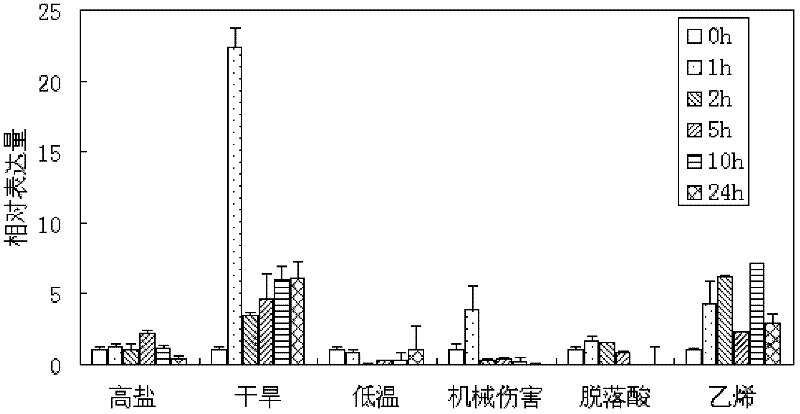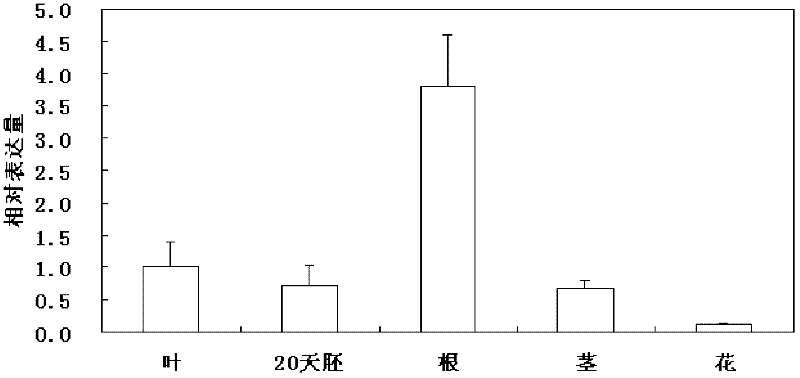Soybean ethylene responsive factor (ERF) transcription factor, and coding gene and salt tolerance application thereof
A technology of transcription factors and coding genes, applied in application, genetic engineering, plant gene improvement, etc., can solve the problem of fewer ERF transcription factors and achieve the effect of improving stress resistance
- Summary
- Abstract
- Description
- Claims
- Application Information
AI Technical Summary
Problems solved by technology
Method used
Image
Examples
Embodiment 1
[0020] Example 1: GmERF7 Gene cloning and sequence analysis
[0021] Soybean RNA extraction and cDNA synthesis: RNAplant plus Reagent (purchased from TIANGEN) was used to extract total RNA from soybean Jilin 32 leaves, and M-MLV reverse transcriptase (RNase H-) (purchased from TaKaRa) was used to reverse transcribe and synthesize cDNA.
[0022] Design and synthesis of primers: The sequences (completed by Huada Genomics) obtained from immature embryo expression profiles of soybean variety Jilin 32 at three stages (20, 30 and 50 days) were input into NCBI for Blast comparison to obtain a Unknown cDNA sequence with high homology of ERF transcription factor protein sequence. According to the obtained unknown cDNA sequence, whose nucleotide sequence is as described in Sequence No.1, design synthetic primers, F: 5'-GAGACACAGCCATTGTTTGTTTAC-3', R: 5'-GGTTTTCTTGCTGTGGATTC-3'. Using the above cDNA as a template, carry out PCR amplification according to the following reaction system a...
Embodiment 2
[0024] Example 2: GmERF7 Expression patterns of genes induced by stress
[0025] Stress treatment of soybean Jilin 32: using Hoagland culture medium (Ca(NO 3 ) 2 4H 2 O 0.62 g / L, KNO 3 0.34 g / L, KH 2 PO 4 0.06 g / L, NH 4 NO 3 0.053 g / L, MgSO 4 0.24 g / L, MgCl 2 0.67 mg / L, H 3 BO 3 0.38 mg / L, MnSO 4 0.2 mg / L, ZnSO 4 ·7H 2 O 0.29 mg / L, CuSO 4 0.01 mg / L, FeSO 4 ·7H 2 O 0.02785 g / L, EDTA-Na 2 0.0373 g / L, pH 5.7-5.8), 28°C, 16 h light / 8 h dark conditions to cultivate soybean hydroponic seedlings, and the hydroponic seedlings at the four-leaf stage were subjected to the following treatments:
[0026]High-salt (NaCl) treatment: Place soybean seedlings in Hoagland culture solution containing 200 mmol / L NaCl, take samples after treatment for 0h, 1h, 2h, 5h, 10h and 24h, place them in liquid nitrogen quickly, and store them at -80°C Save for later use;
[0027] Drought treatment: Soybean seedlings were placed in Hoagland culture solution containing 20% PEG80...
Embodiment 3
[0037] Example 3: GmERF7 Gene Expression Patterns in Soybean Tissues
[0038] Total RNA was extracted from the roots, stems, leaves, flowers, and 20-day embryos of soybean Jilin 32 and reverse-transcribed into cDNA. The method was the same as in Example 1. Real-time fluorescent quantitative PCR was carried out using the cDNA of the above-mentioned roots, stems, leaves, flowers and 20-day embryos as templates, and the method was the same as in Example 2.
[0039] GmERF7 The relative expression level (mean value) of genes in different soybean tissues:
[0040] organize leaf 20 day embryo root stem flower relative expression 1 0.71475 3.80061 0.667293 0.131047
[0041] The results show GmERF7 The expression level of the gene was the highest in the root of soybean, and the expression level was in the following order: root﹥leaf﹥20-day embryo﹥stem﹥flower.
PUM
 Login to View More
Login to View More Abstract
Description
Claims
Application Information
 Login to View More
Login to View More - R&D
- Intellectual Property
- Life Sciences
- Materials
- Tech Scout
- Unparalleled Data Quality
- Higher Quality Content
- 60% Fewer Hallucinations
Browse by: Latest US Patents, China's latest patents, Technical Efficacy Thesaurus, Application Domain, Technology Topic, Popular Technical Reports.
© 2025 PatSnap. All rights reserved.Legal|Privacy policy|Modern Slavery Act Transparency Statement|Sitemap|About US| Contact US: help@patsnap.com



